Latest News
March 1, 2013
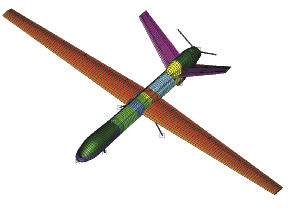 |
Great engineers are usually Renaissance types “those dynamos who manage to know and do a bit of everything in and out of their field. They listen, they learn, they push limits, but they also recognize when a solution is best left to the experts.
Working with an outside, expert service may be the right course for you to follow, too, when a product or system needs mechanical testing, whether for validation, comparison or certification purposes.
Fortunately, specialty testing companies are here to help, offering equipment, services and years of experience that can accommodate products from tiny medical devices to full-size drone aircraft. DE asked a number of testing companies to share their thoughts on making the most out of using their services.
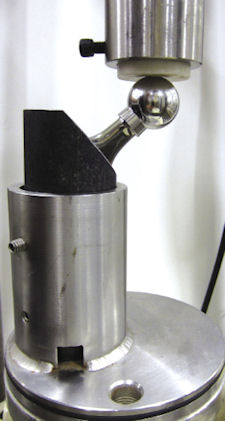 Hip implant test set-up at Accutek Testing Laboratory, based on a specific test procedure in Method ISO 7206 for measuring endurance and fatigue testing of artificial hip implant prostheses. Image courtesy of Accutek Testing Laboratory. |
Why Use Outside Test Sources?
Erin McCloy, director of marketing at Accutek Testing Laboratory in Fairfield, OH, offers four key reasons why it makes sense to hire out testing:
1. They’ve made the rookie mistakes long ago. She explains that if you’re doing a test for the first time and setting up monitoring equipment, you might get well into the program and find, for example, you’ve chosen the wrong transducer.
2. They let you focus on your core business. If you are a developer of a hip implant, you’re good at developing. You know how to manufacture, but learning the science of testing is a completely different animal. “Just like you outsource your shipping to UPS, outsourcing your testing to somebody who is experienced allows you to focus,” McCloy explains.
3. They offer an independent, non-biased, accredited testing option. Accutek, for example, holds a number of accreditations with groups such as ISO and Nadcap (formerly NADCAP, the National Aerospace and Defense Contractors Accreditation Program, a global cooperative accreditation program within the aerospace and automotive industries). These bodies have verified and audited Accutek’s protocols, procedures and quality assurance programs. McCloy notes this is especially important for backing up a client’s marketing and performance claims.
4. They operate on economies of scale, owning and maintaining multiple sets of test equipment and fixed-cost items. Running tests on, say, 100 samples of a composite part in a timely manner would be a challenge for a design company owning a single test set-up “but would be fast and straightforward at a testing service with duplicate stations.
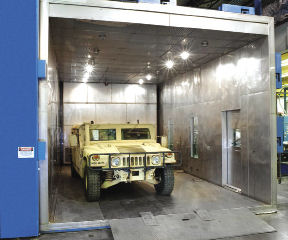 Humvee vehicle in Dayton T. Browns environmental test chamber for MIL-810 low-temperature testing. Image courtesy of Dayton T. Brown. |
What Tests Do You Need?
Mechanical tests fall generally into the categories of physical properties, thermal response, and static/dynamic behavior. The most commonly performed include vibration testing (random, sine, shock), drop/impact, temperature/humidity, strain/fatigue and altitude/pressure differential. Within these areas, engineers can choose from thousands of test procedures “some general in concept and some very specific, such as fastener or chain testing, salt-fog corrosion resistance, and sterile-barrier immersion testing (for medical packaging).
Systima Technologies, a Bothell, WA-based testing company, defines these categories in great detail. For example, within vibration, an electro- dynamic shaker can provide sine, random and mixed-mode vibrations, as well as classical shock and shock response spectrum (SRS) analysis. Systima’s specialties include pyro/mechanical shock and highly accelerated life testing (combining vibration and thermal shock).
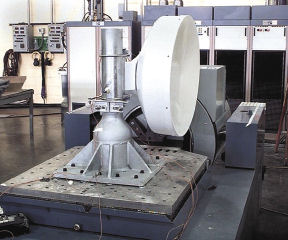 An antenna undergoing MIL-810 vibration testing at Dayton T. Browns testing facilities. Image courtesy of Dayton T. Brown. |
Herb Schueneman, president of San Jose, CA-based Westpak, says that most of what his company does consists of mechanical shock and vibration testing, temperature and humidity testing, altitude or pressure differential testing, and outdoor exposure testing, including sunlight, ultraviolet (UV), thermal cycling, etc.
“Most often, a client will come to our facilities to test for compliance with a given specification, condition or requirement,” he says. “There are, however, many clients who use our facilities to fix a problem or issue that has arisen. Often this occurs during transportation, but it may also happen in the customer’s environment.”
For the latter instances, Westpak will recommend test procedures and protocols that have shown promise in similar situations in the past.
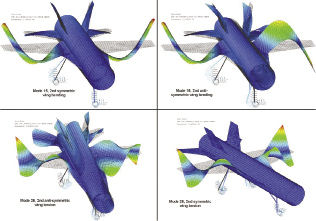 Example of modal test data supplied to a client, based on an iron bird test bench model used for R&D and training at ATA Engineering. Image courtesy of ATA Engineering. |
The more you know about testing procedure details, the better (and more efficiently) these tests will fulfill your requirements. At Dayton T. Brown, a New York testing facility, Bill Bradshaw, vice president and chief engineer, points out that settling on the details of test requirements can be time-consuming. “Provide as much information about the test and the test item as possible,” he advises. “For example, even if it is a straightforward temperature test, does the item weigh 5 or 5,000 lbs.? Must the item be powered during or after the test? What are the power requirements? What are the cooling requirements?”
Other important questions include: Will you be onsite for the testing to operate/move the item in-between tests if necessary? Is the order of test important? Have all stakeholders approved the test plan? Defining these details up front will save time and money, ensuring it is done right the first time.
Interesting References for Mechanical Testing
|
Pricing and Deliverables
Some tests are engineering-intensive but quick to run, while others may go for days or months. Pricing at most testing facilities is time-based, although quantity and type of equipment can come into play.
Dave Hunt, vice president of business development at ATA Engineering, says his company bases its price on the number of labor-hours, plus the test equipment required to perform the test. Noting another good reason to work with experts, Hunt says, “We can almost always accurately estimate the time required to perform a test, and from that, offer a fixed price contract. Customers appreciate that vs. an open-ended ‘pay-as-you-go’ contract where the total cost is undetermined.”
Getting his facility involved early helps save overall cost and schedule, explains Hunt, because his staff can often suggest ways to optimize the test and define a clear objective.
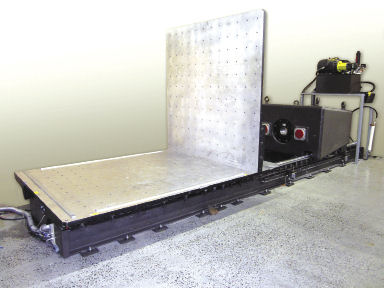 This horizontal impact test system (HITS), designed by Westpak testing services, studies the effects of auto and truck impacts, rail car coupling and similar horizontal-shock events. Image courtesy of Westpak. | 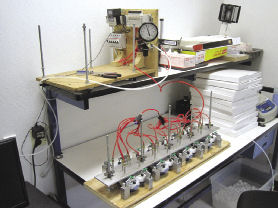 Test set-up to determine the reliability of finger-pushed buttons, such as on a remote-control device, at Westpak testing services. Millions of cycles are possible in a short time period. Image courtesy of Westpak. |
Typical result deliverables include a detailed written report that covers all aspects of the test, including test objectives and approach, measurement locations, test equipment and calibrations, test setup and performance, data analysis and results. Formats range from universal files to spreadsheets, and can include commercial codes such as MATLAB.
“We also provide raw as well as processed test data in a mutually agreed-to format that allows customers to perform their own post-processing,” Hunt says. “Even more than that, ATA provides conclusions and insight to the ‘why’ of the test results.”
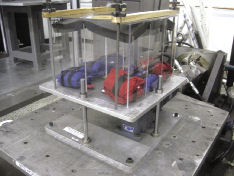 Vibration test unit built by Westpak testing services to learn of the effects jogging has on personal devices such as cell phones, recording devices, blood glucose meters and similar devices. Image courtesy of Westpak. | 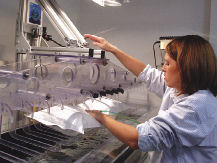 Sterile barrier immersion-test conducted on an inner packaging system of medical devices, at Westpak testing services. Image courtesy of Westpak. |
Trends and Specialties
Testing for specific industries such as medical implants is becoming more in demand, as is testing on composite materials (the hottest thing, according to Accutek) and combined-environment testing. An example of the latter is one that combines wind-induced vibration with temperature oscillation for such units as solar modules.
“There has been a jump in private space-related work that has caused mechanical test levels to become more extreme,” adds Nathaniel McDonald, lab manager at Systima Technologies. “Many of the test levels we see today push well beyond the standards we saw for automotive and aerospace. We are working hard to keep up with these new test extremes.”
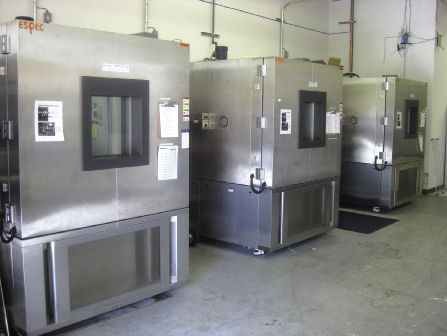 Chambers for conducting product tests over rapid temperature and humidity changes, at Westpak testing services. Image courtesy of Westpak. | 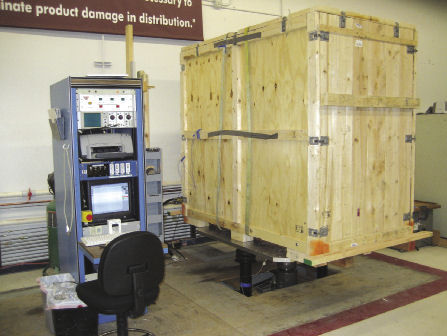 This large shipping container is undergoing a transit vibration test at Westpak testing services. Image courtesy of Westpak. |
ulations and hands-on testing to evaluate and guide product design. ATA’s Hunt sees the value of a closed-loop approach, saying, “Early testing in the design process can yield great benefits later in the development process by improving the ability to validate modeling assumptions, leading to improved computer simulations. The need for testing will never go away; as new materials and manufacturing processes are developed, the number and types of tests will also evolve “to define those tests that provide the best value to the overall development process.”
Hunt points out that reducing overall test time will continue to be a goal of many companies: “Better yet, successful companies will be able to identify those tests that provide the most value to their processes, and implement them in a cost-effective manner.”
Getting the Most out of Testing
Having a single person responsible from the sale through the process can be a plus when working with a testing service.
5 Benefits of Outsourced Mechanical Testing
|
“The single biggest cost of conducting testing at the Westpak laboratories is not the equipment, not the labor and not the overhead,” asserts Schueneman. Rather, he says it’s “simply the coordination of the test, including making sure that the samples arrive on time and in good condition, that the test procedures are properly understood—especially any variations required—and that all communication between the client and the testing laboratory is complete, including the contract (purchase authorization). This coordination winds up taking more time and effort than all the other individual components in most single tests.”
As Accutek’s McCloy concludes, “Testing is a unique industry compared to a lot of other products and services out there.” Perhaps it’s time to explore how your company can bring the strengths of outside testing to the front-end of your design process.
Contributing Editor Pamela Waterman, DEs simulation expert, is an electrical engineer and freelance technical writer based in Arizona. You can send her e-mail to [email protected].
MORE INFO
Subscribe to our FREE magazine, FREE email newsletters or both!
Latest News
About the Author
Pamela Waterman worked as Digital Engineering’s contributing editor for two decades. Contact her via .(JavaScript must be enabled to view this email address).
Follow DE




